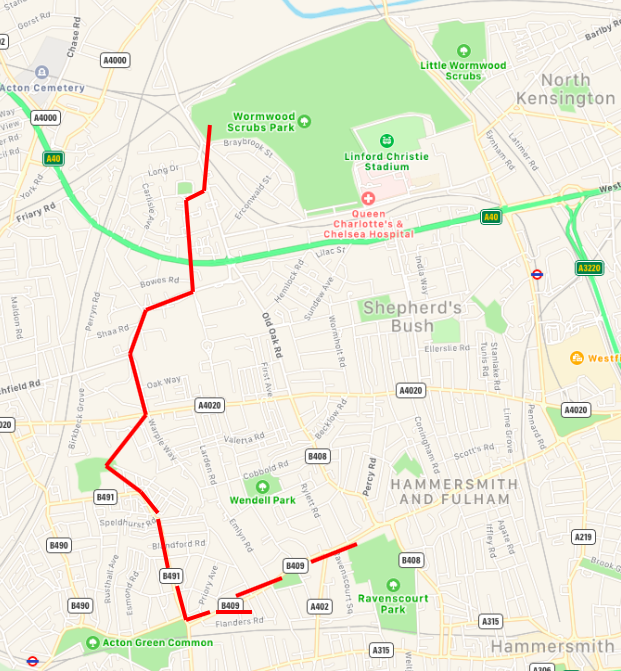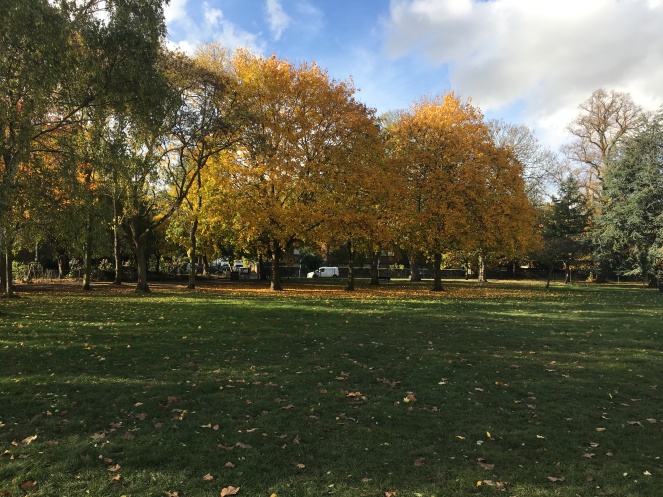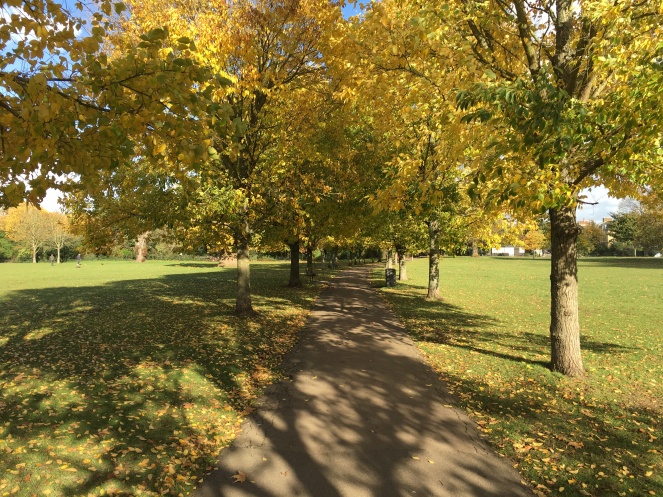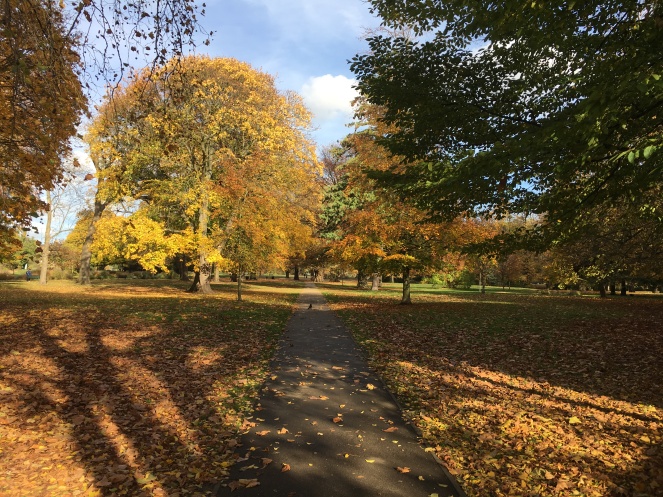Welcome one and all as I take another stroll across the capital! For my walk today I’ll be embracing the colours of Autumn as I explore Hammersmith & Fulham and Acton to really get into the spirit of the changing of the season. I’ll begin in Ravenscourt Park, go past Acton Green Common and Acton Park before ending my journey at Wormwood Scrubs. So grab the coat, scarf and walking boots!

I start my walk in Ravenscourt Park which is an 8.3 hectare (20.5 acre) public green area in the borough of Hammersmith & Fulham. Its origins date back to the medieval manor and estate of Palingswick (or Paddenswick) Manor which was first recorded on the site in the 12th century. The name still has significance to the area today with a Paddenswick Road near Ravenscourt Park.


Back in the 13th century the Manor House within Ravenscourt Park had a moat surrounded by it which today forms part of the lake that is within the park. Whilst in the 14th century the Manor was occupied by King Edward III’s mistress Alice Perrers.
In 1650 the Manor House was rebuilt and in 1747 renamed Ravenscourt after it was sold to Thomas Corbett with the name Ravenscourt probably deriving from the raven on his coat of arms.


Private owner George Scott who was a builder and philanthropist bought the Ravenscourt House in 1812 and a leading landscaper by the name of Humphry Repton helped to lay down the gardens in the estate. Park plans in 1830 indicated that there were 78 houses within the park which had risen to 330 by 1845. The Ravenscourt House was also the first public library in Hammersmith in 1889.

George Scott’s family sold the estate to a developer in 1887 with it being acquired by the Metropolitan Board of Works. A year later in 1888 a public park was laid out by J.J. Sexby with the management of the park transferring to the London County Council in 1889. In 1941 the building suffered severe damage during the Second World War. However, in 1965 the park was owned by the Greater London Council and finally the London Borough of Hammersmith in 1971.
The park’s café today is the old stables of the manor and is certainly one of the grandest café’s in London! The park also has a variety of facilities including football pitches, tennis & basketball courts and a playground.

Walking through the park you really get a sense that the season is changing with an array of beautiful colours, all of which look like a watercolour painting and many different shades of yellow, brown, red, orange and gold. When you look at the vast area of the park as well as the lake which used to be the Manor’s moat, you can get a feeling of how the grand estate would’ve looked. The lake is something to behold and matched with the trees colours, it makes for the perfect picture, or painting!






It’s now time to leave the tranquility of Ravenscourt Park to go in search of more pretty autumnal colours in my next stop Acton Green Common. Located next to Turnham Green tube station, the 5.9 hectare (14.5 acres) common is quite unique given that it’s split into two, with a road and crossing in between it.


The Acton Green Common has a place in history as part of the site of the Battle of Brentford during the Civil War when on the 12th November 1642 the Royalists under Prince Rupert surprised them and beat the Parliamentarian army under Lord Essex.
I do love the symmetry where you have trees either side of the pathway and as far as you can see there are trees across the green. Once again the crisp orange colouring comes out perfectly with the sun shining on them which really does brighten up the park. Also the lengthening shadows illustrates the sun is getting lower and winter is on its way.


I’m now going to make my way out of Acton Green Common and onto yet another lovely green space, Acton Park. One aspect you get when walking around Acton is that the trees aren’t just confined to the parks as they can be seen across the roads and houses!

Acton Park first opened to the public in 1888 as a commemoration to the Golden Jubilee of Queen Victoria and in 1945 the park’s allotments were converted into temporary houses for ex-servicemen.


In London we’re so lucky that nearly every area has some kind of green space where you can relax in the peace and quiet of a park setting. Also it’s not just the grass areas which I love, but the variety of trees are also so remarkable, big ones, tall ones, small ones, thin ones, the list is endless and all have their own distinct look and personality. You really don’t get this when you walk around some areas of central London, so you do have to go off track into the London boroughs to see all of natures glory.


It’s now time to leave Acton Park and move onto my final autumnal destination, the quite unique Wormwood Scrubs! Based in the North-Eastern corner of Hammersmith & Fulham, the area is the largest open space in the borough at 80 hectares (200 acres) and is one of the largest commons in London.


The park has been open to the public since 1879 and was even the home of Queens Park Rangers Football Club in the late 1888s.
Its history dates back to the early 19th century when the entire district of Hammersmith & Fulham was open fields with several areas of common land. In 1812 a 77 hectare (190 acre) area known as Wormholt Scrubs was leased by the War Office from the Manor of Fulham. The area was used to exercise cavalry horses which until then had used Hyde Park, Belgrave Square and Regent’s Park. In 1878, 55 hectares (135 acres) of the land became known as Wormwood Scrubs after being bought by the War Office.

In order to create metropolitan exercising ground for the military, in 1879 Parliament passed the Wormwood Scrubs Act. This act enabled the military to expel civilians from the area whenever they were training, but allowed civilians free use of it when they were not. The military were banned from building any permanent structures other than rifle butts on the open land.
The area gained the reputation of being one of the duelling grounds of London with several duels being fought there. The scrubland played a part in the 1908 Olympics with the marathon’s final stages going through it on the route from Windsor Castle to the Olympic Stadium in White City.
In 1910 Wormwood Scrubs gained a significant contribution in aviation history when pioneering airships took flight from an improvised landing ground. Four years later in 1914 all air related activities on the scrubs passed to the authority of the Admiralty with the area remaining an emergency landing ground until the 1930s. During the Second Wold War, the scrubs hosted the military department called The Chief Cable Censorship Department, an outstation of the Government Code and Cypher School at Bletchley Park.

Back in 1986 local birdwatcher Lester Holloway set up a campaign to save Scrubs Wood which was under threat from plans by British Rail to turn it into a cleaning depot. The campaign would succeed with an area of the nature reserve known as ‘Lester’s Embankment’ in 1987.
There has been many conservation efforts undertaken on the area with the park home to over 100 species of birds, 250 species of wildflowers, bats and lizards.
The entire area really is something to behold, as it’s a vast area of meadowland with hardly anything around it, there aren’t too many trees or houses, just scrubland and long grass. I have to say it’s one of the first times my walks have taken me to such a place and it’s eerily quiet when you’re stood in the middle of it as there’s literally no one walking through or by it. This is one of the reason why I love exploring London as you come across such weird and wonderful places like this which you’d not normally come across, or even know about.
Well that’s all from me today folks! I hope you enjoyed discovering some of West London’s best green areas which showcased the colours of autumn so amazingly well, which I’m sure you can agree are looking absolutely golden at the moment! I’ll be discovering more of beautful autumnal London next time!
In the meantime you can catch me on Twitter and Instagram and don’t forget to sign up to my blog too and have a read of my other walks, from river ones to park ones, there’s something there for you! 🙂
Sources: (not the food sauces)
All photos taken by London Wlogger unless stated. © Copyright 2018
Friends of Ravenscourt Park: History of Ravenscourt Park
Parks and Gardens: History of Acton Green Common
Ealing.Gov: History of Acton Parks
London Borough of H&F: History of Wormwood Scrubs

Thanks for the parks tours. I’ve spent two London visits staying next to Ravenscourt Park and never saw a cafe! Loved the park, though.
And where did I get the idea that Wormwood Scrubs was a prison? Much prefer the thought of bird watching.
LikeLiked by 1 person
Haha it’s quite hidden but it’s one of the finest cafes you’ll ever see! You’re very right, there is indeed a prison there… but bird watching is a happier topic 😉
LikeLike
I’m always amazed by all the green spaces in London and there is so much history everywhere we go. The autumn colours in the trees are very beautiful on a sunny day.
LikeLiked by 1 person
It always fascinates me that every area I visit has an intriguing story to tell, something you can’t really plan in advance knowing what the areas history is, you just find out about it!
We’re very fortunate that trees, rivers, parks and green spaces are never too far away, that’s why London is so special compared to other places!
Sunlight on golden leaves is magical 😃
LikeLiked by 1 person
I wallowed in your gorgeous photos. Our autumn season lasted 5.7 days. The leaves stayed green far too long. Strong winds shredded them, so we had hardly any color.
LikeLiked by 1 person
Oh that’s a shame, one of the beauty’s of autumn to winter is seeing the gradual change in the colours of the leaves! Glad you enjoyed the photos ☺️
LikeLiked by 2 people
Lovely autumn colour pictures. When I read your opening remark ‘…before ending my journey at Wormwood Scrubs’ I feared you might be returning to your cell. Pleasing to see I should not have worried 🙂
LikeLiked by 1 person
Haha not just yet 😉😂 Thank you for reading ☺️
LikeLiked by 1 person
Beautiful! Thank you for the outstanding photos!🌞
LikeLiked by 1 person
Aww thanks so much!
LikeLiked by 1 person
When I went to Wormwood Scrubs in the late 1950s parts in it were fenced off as there may have been unexplored bombs there. I loved it because it was wild and untamed with strange scary ruins. Looks like all that was removed. Nice to see some wild areas there still.
LikeLiked by 1 person
Ah yes it does have a very common theme of war and military activity on it which must have continued right up until the 1950s! Yeah it’s very wild and meadowy, perfect habitat for wildlife ☺️
LikeLike
I was walking down those beautiful green spaces 🙂
LikeLiked by 1 person
They’re truly spectacular!
LikeLiked by 1 person
Looks like a lovely walk!
LikeLiked by 1 person
The sights on it were so pretty at this time of year! Hope you enjoy all my other walks 😊
LikeLike